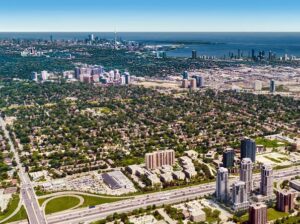Etobicoke, Ontario
October 10, 2023 By: Bruno Knopfel
Location: 26 Gibbs Road, Etobicoke Ontario

According to Wikipedia, the lands now known as Etobicoke bore witness to a number of First Nations communities. It is believed that Algonquian tribes, journeying from the Atlantic to the shores of Lake Erie, established their presence in this territory. The Huron-Wendat were the primary residents of Lake Ontario’s north shore, forming a deep connection with the waters. Yet, the 17th century brought turbulent times for the Huron-Wendat. They faced adversity from the Iroquois, Ojibway, and Potawatomi, fellow Algonquin nations fighting for dominion. The land resonated with the convergence of diverse cultures and aspirations, leaving enduring marks on its venerable soil. As time flowed on, the tides of territorial sway shifted. Rival nations ceded ground, heralding a new era. Around 1695, the Mississaugas emerged as the settlers of this fertile domain. In the embrace of summer’s abundance, the Mississaugas flourished as adept fishermen and dedicated farmers of the land. When winter’s unyielding grasp took hold, hunting assumed a key role, ensuring survival through the cold.
Settlement started to happen when 1787 when the British signed the Toronto Purchase agreement with the Mississaugas which included land from the Scarborough Bluffs to Etobicoke Creek, the Mississaugas government disagreed with the boundaries of the purchase, this was finally settled in 2010. Amongst new settlers were Immigrants from the British Isles, Loyalists who had left the rebellious Thirteen Colonies, by then the United States. In 1793-95 coronel of the Queens’ Rangers, Lieutenant Colonel Samuel Smith received land grants of 1,530 acres.
In 1787, a significant event unfolded with the signing of the Toronto Purchase agreement between the British and the Mississaugas. This important agreement included a substantial tract of land, stretching from the Scarborough Bluffs to Etobicoke Creek. However, a dispute arose over the precise boundaries of the purchase, leading to years of negotiation. It wasn’t until 2010 that this matter was ultimately resolved, shedding light on the true parameters of the acquisition. Among the early settlers were immigrants hailing from the British Isles, seeking fresh opportunities in this promising new territory. Additionally, there were the Loyalists, individuals who had departed from the rebellious Thirteen Colonies, now the United States. Their quest for a fresh start led them to these shores. During this period, Lieutenant Colonel Samuel Smith of the Queens’ Rangers emerged as a notable figure, receiving extensive land grants totaling 1,530 acres. This allocation represented a substantial stake in the burgeoning landscape of the time. Thus, the late 1700s marked a significant chapter in the history of this region, characterized by the convergence of diverse groups and the establishment of enduring settlements.
As the War of 1812 loomed, the population in this area was modest, numbering just 250 individuals, with a notable fifth of them enlisted in the British army. The conflict brought about significant changes, and when the dust settled, Britain found itself grappling with a depression. Surprisingly, this economic downturn led to an unexpected surge in population for the Etobicoke region. By 1839, the headcount had ballooned to 1,874, a remarkable transformation in just a few decades. Over the next 30 years, this trend of growth persisted. The industrious residents started clearing the original forests, resulting in 90% of the land becoming arable. Agriculture became the main economical activity. Specializing in wheat, dairy, livestock, and fruit farming.
Farming continued until after World War II. However, the post-war baby boom brought about a big transformation in the region, shaping it into what it is recognized today. Families began to move into the area, seeking both home and job opportunities. By early 1970s, most of the land was repurposed for housing, leading to a population rise of nearly 300,000 people. This marked a significant evolution in the area’s demographic and economic landscape.
I also found a report from the Toronto Historical Association about an area known as Etobicoke Creek that covered a vast expanse of 205 square kilometers, once a thriving wetland teeming with diverse wildlife. It served as the habitat for passenger pigeons; sadly, their extinction occurred in 1902 due to extensive logging and overfishing. While this event stands as a notable example of the significant impact on wildlife within the region, it is likely that there were other instances as well, such as the lack of salmon runs upriver due to urbanization.
The area also served as a vital space for Aboriginal communities to cultivate crops like corn, squash, and beans. Despite the British assurance of fishing rights for the Mississauga Indians in the river, they were regrettably displaced by the encroachment of commercial fishermen and advancing settlements by the year 1871. Between the two World Wars, the region underwent continuous development, resulting in the establishment of industrial and residential zones, as well as the construction of two major highways. Unfortunately, this rapid expansion contributed to the pollution and contamination of the water in the area.
While Etobicoke may not have experienced environmental changes as drastic as downtown Toronto, the region has nonetheless been and continues to be influenced by urbanization. This is particularly evident considering the challenges related to housing affordability closer to the downtown core, which in turn triggers substantial transformations in the area. Regrettably, this scenario is not unique to Etobicoke, as many major urban centers in Eastern North America, where European settlers first established themselves, face similar circumstances.
References
Etobicoke Creek Mouth. (n.d.). Toronto Historical Association. Retrieved October 10, 2023, from http://www.torontohistory.net/etobicoke-creek-mouth/
Brief History of Etobicoke. (n.d.). Etobicoke Historical Society. https://www.etobicokehistorical.com/brief-history-of-etobicoke.html
Etobicoke. (2023, September 8). Wikipedia. https://en.wikipedia.org/wiki/Etobicoke#Economy